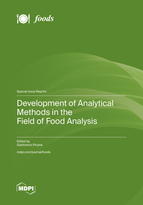Development of Analytical Methods in the Field of Food Analysis
A special issue of Foods (ISSN 2304-8158). This special issue belongs to the section "Food Analytical Methods".
Deadline for manuscript submissions: closed (31 March 2023) | Viewed by 22948
Special Issue Editor
Interests: metabolomics; HR-NMR; foodomics; nutrimetabolomics; chemometrics
Special Issues, Collections and Topics in MDPI journals
Special Issue Information
Dear Colleagues,
Any product intended for human consumption needs to be rigorously tested, and because foodstuffs are ingested, the testing is often especially crucial to prevent any potential health issues. Thus, food analysis is a very important branch of analytical chemistry, as it provides information about the chemical composition, processing, quality control, and contamination of foodstuffs, ensuring compliance with food and trade laws. For this reason, it impacts both the economic and medical aspects of modern societies. The development of analytical methods in food matrices, as well as the understanding of how the food matrix influences nutrients’ bioaccessibility, has always been difficult due to the large variety of their physicochemical properties. In terms of the techniques that are used to name a few common examples, the range of instruments includes nuclear magnetic resonance (NMR) spectroscopy, gas chromatography (GC), atomic absorption spectroscopy (AAS), and high-performance liquid chromatography (HPLC). The choice of technique(s) depends on what foodstuff is being analyzed, what is being analyzed within the foodstuff, and the reasons for the analysis, which can change analyte structure and extraction efficiencies because of different processing procedures throughout preparation and distribution.
Furthermore, the multiplexing trend, which means the simultaneous detection of multiple analytes at the same time, requires the development of more appropriate sample preparation methods, as well as instruments that take into account such factors as sustainability, green chemistry, and operator intervention.
This Special Issue is open to submissions that explore the development of analytical methods in the field of food analysis, which also includes topics such as in vitro digestion and nanotechnology in food safety and quality assessment. Original works and reviews are welcomed.
Dr. Gianfranco Picone
Guest Editor
Manuscript Submission Information
Manuscripts should be submitted online at www.mdpi.com by registering and logging in to this website. Once you are registered, click here to go to the submission form. Manuscripts can be submitted until the deadline. All submissions that pass pre-check are peer-reviewed. Accepted papers will be published continuously in the journal (as soon as accepted) and will be listed together on the special issue website. Research articles, review articles as well as short communications are invited. For planned papers, a title and short abstract (about 100 words) can be sent to the Editorial Office for announcement on this website.
Submitted manuscripts should not have been published previously, nor be under consideration for publication elsewhere (except conference proceedings papers). All manuscripts are thoroughly refereed through a single-blind peer-review process. A guide for authors and other relevant information for submission of manuscripts is available on the Instructions for Authors page. Foods is an international peer-reviewed open access semimonthly journal published by MDPI.
Please visit the Instructions for Authors page before submitting a manuscript. The Article Processing Charge (APC) for publication in this open access journal is 2900 CHF (Swiss Francs). Submitted papers should be well formatted and use good English. Authors may use MDPI's English editing service prior to publication or during author revisions.
Keywords
- analytical methods
- food security
- mass spectrometry
- raman spectroscopy
- nmr spectroscopy
- chromatography
- solid-phase microextraction
- sampling and sample preparation
- nanomaterials in diagnostics
- green chemistry
- in vitro digestion
- metabolomics







